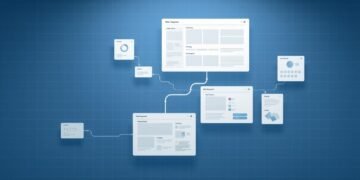Have you ever wondered what it takes to bridge the gap between stakeholders and IT teams effectively? In today’s data-driven world, the role of a professional who connects these two worlds is more critical than ever. This article dives into the essentials of building a successful career in this field, focusing on the tools, templates, and deliverables that make a difference.
The demand for skilled individuals in this area is skyrocketing, especially in industries like finance, healthcare, and IT. With an average salary ranging widely based on experience, there’s never been a better time to explore this career path. Structured learning and mastering analytical tools are key to unlocking your potential.
Whether you’re just starting or looking to advance, understanding the importance of technical proficiency and problem-solving frameworks is crucial. This guide will help you navigate the complexities of the role and highlight the growing opportunities in this field.
Key Takeaways
- Learn the critical role of connecting stakeholders and IT teams.
- Discover the importance of structured learning and analytical tools.
- Understand the salary potential and demand across industries.
- Explore the benefits of technical proficiency and problem-solving skills.
- Find out how certifications can enhance your career prospects.
What is a Business Analyst?
Ever wondered who solves the puzzle between business goals and technical solutions? A business analyst acts as both an investigator and a communicator. They identify operational issues, like website checkout problems, and translate findings into actionable solutions.
Their core responsibility is bridging business objectives with technical implementation. For example, if an organization sees a sales decline, a business analyst might analyze traffic data and recommend UX improvements.
Key deliverables include process documentation, requirement specifications, and workflow diagrams. These tools help streamline operations and ensure clarity across teams.
Stakeholder management is another critical aspect. Business analysts work closely with departments like finance, IT, and operations to align everyone’s goals.
While data analysts focus on pure data insights, business analysts have a broader operational focus. They ensure that the organization’s needs are met through effective solutions.
Why Pursue a Career in Business Analysis?
What makes a career in business analysis so rewarding and in-demand? This profession offers a unique blend of strategic thinking, problem-solving, and technical execution. It’s a field where you can make a tangible impact on organizational success while enjoying diverse opportunities across industries.
The demand for skilled professionals in this role is skyrocketing. Industries like tech, healthcare, and finance are actively seeking individuals who can bridge the gap between data and decision-making. This high demand translates into excellent job security and competitive salaries.
For those looking to become a business analyst, the career progression is impressive. Starting as a junior analyst, you can advance to roles like consultant, project manager, or even COO. Hybrid work opportunities also make this career appealing, blending remote flexibility with in-office collaboration.
Certifications like CBAP (Certified Business Analysis Professional) can boost your earning potential by up to 25%. Mid-career professionals in India, for example, earn between ₹8-15 LPA. Globally recognized credentials, such as those from IIBA, ensure your skills are portable across borders.
Job satisfaction is another key benefit. Solving complex problems and seeing your solutions drive business outcomes is incredibly fulfilling. If you’re looking for a career in business that combines creativity, strategy, and technical expertise, this is the path for you.
Essential Skills for a Business Analyst
What does it take to excel in a role that blends strategy, technology, and teamwork? Success hinges on mastering a combination of analytical thinking, communication, and technical proficiency. These skills ensure you can solve complex problems, collaborate effectively, and leverage the right tools to drive results.

Analytical Thinking and Problem-Solving
At the core of this role is the ability to analyze data and identify solutions. Professionals often use frameworks like SWOT and PESTLE to make strategic decisions. These methods help break down complex issues into manageable parts.
For example, if a company faces declining sales, an analyst might use these frameworks to pinpoint root causes. This approach ensures solutions are both effective and aligned with organizational goals.
Communication and Collaboration
Clear communication is vital for working with diverse teams. Techniques like stakeholder interviews and requirement elicitation ensure everyone’s needs are understood. Tools like JIRA and Microsoft Teams are widely used to streamline collaboration.
Conflict resolution strategies are also crucial. They help align cross-functional teams and ensure smooth project execution. Strong communication fosters trust and keeps projects on track.
Technical Proficiency
Technical skills are non-negotiable in today’s data-driven world. SQL is essential for database querying, while Python is often used for automation. Tools like Tableau and BPMN 2.0 are critical for data visualization and process mapping.
Mastering these analysis tools allows professionals to handle complex processes efficiently. Technical expertise ensures you can translate data into actionable insights.
Educational Background and Certifications
What educational path sets you up for success in a dynamic and data-driven field? A strong foundation in a bachelor degree is often the first step. Popular majors include Business IT, Computer Science, and Economics. These programs provide the knowledge skills needed to analyze data and solve complex problems.
For those aiming higher, a master’s degree in business administration or related fields can open doors to advanced roles. Programs like these deepen your understanding of strategic decision-making and leadership. Many universities also offer hybrid education paths, combining online courses with practical work experience.
Certifications are another way to boost your career. IIBA’s ECBA, CCBA, and CBAP certifications can increase earnings by 18-25%. The CBAP certification, in particular, offers a 42% salary premium. Other top certifications include PMI-PBA, which has seen a 31% demand growth.
Preparing for these exams requires dedication. Most professionals spend 100-200 study hours for the CBAP. University partnerships, like Coursera’s Business Analytics Specialization, have an 89% completion rate. These programs provide structured learning and practical insights.
Whether you choose a traditional degree or a hybrid path, investing in education and certifications is key. It equips you with the knowledge skills and credentials needed to excel in this competitive field.
Key Tools for Business Analysts
What tools can elevate your ability to analyze and manage complex processes? In today’s data-driven world, leveraging the right tools like Tableau, JIRA, and SQL is essential for success. These tools streamline workflows, enhance decision-making, and improve efficiency across various processes.
Data Visualization Tools: Tableau and Power BI
Tableau and Power BI are leading tools like those used for transforming raw data into actionable insights. Tableau users report 37% faster insights delivery, making it a favorite for enterprises. Power BI, on the other hand, integrates seamlessly with the Microsoft ecosystem, offering robust business intelligence capabilities.
When choosing between the two, consider your organization’s needs. Tableau excels in advanced visualizations, while Power BI is ideal for those already using Microsoft technology.
Project Management Tools: JIRA and Trello
JIRA and Trello are indispensable for managing projects and workflows. JIRA manages 83% of Agile projects, offering advanced configurations for backlog grooming and sprint planning. Trello, with its intuitive interface, is perfect for smaller teams or simpler processes.
Both tools enhance collaboration and ensure projects stay on track. JIRA’s flexibility makes it a top choice for complex workflows, while Trello’s simplicity appeals to teams seeking quick solutions.
Data Analysis Tools: SQL and Python
SQL and Python are critical tools like those used for data analysis. SQL is essential for querying databases, with optimization techniques like indexing and partitioning improving performance on large datasets. Python, with libraries like Pandas and Scikit-learn, is ideal for data cleaning and predictive modeling.
Mastering these tools can significantly boost your analytical capabilities. Certifications, such as the Tableau Desktop Specialist, can also provide a 19% salary bump, making them a worthwhile investment in your career.
Business Analysis Techniques
How do professionals tackle complex organizational challenges effectively? By leveraging proven techniques, they can identify opportunities, mitigate risks, and drive meaningful solutions. These methods are essential for aligning organizational goals with actionable plans.

SWOT Analysis
SWOT Analysis is a cornerstone technique for evaluating internal and external factors. It helps organizations understand their Strengths, Weaknesses, Opportunities, and Threats. This approach is particularly useful for competitive positioning and strategic planning.
For example, a company might use SWOT to assess its market position before launching a new product. By identifying potential challenges, they can develop strategies to overcome them and capitalize on opportunities.
PESTLE Analysis
PESTLE Analysis focuses on external factors that impact an organization. It examines Political, Economic, Social, Technological, Legal, and Environmental influences. This framework is ideal for global market entry strategies.
Research shows that PESTLE identifies 42% of market risks, making it a valuable tool for decision-making. It ensures organizations are prepared for external challenges and can adapt their processes accordingly.
Business Process Modeling (BPM)
Business Process Modeling (BPM) is a systematic approach to documenting and improving workflows. It uses standards like BPMN 2.0 to create clear, cross-departmental diagrams. This technique ensures efficiency and clarity in organizational processes.
Did you know 67% of Fortune 500 companies use BPMN? It’s a testament to its effectiveness in streamlining operations and driving solutions. By visualizing workflows, teams can identify bottlenecks and implement improvements.
Steps to Become a Business Analyst
Starting a career in this field requires a strategic approach to skill-building and hands-on learning. To become business-ready, you’ll need to focus on acquiring core competencies, mastering programming languages, and gaining practical experience through real-world projects. These steps will prepare you to tackle complex challenges and stand out in a competitive job market.
Acquire Core Business and Data Analysis Skills
Begin by mastering essential tools like Excel, SQL, and Tableau. These are foundational for data analysis and decision-making. A structured learning path, such as starting with Excel and progressing to SQL and Python, can take 6-9 months. This approach ensures you build a strong base of knowledge before moving to advanced techniques.
Learn Programming Languages for Business Analytics
Programming languages like Python and SQL are critical for handling large datasets and automating tasks. Python, with libraries like Pandas, is ideal for data cleaning and predictive modeling. SQL is essential for querying databases and extracting insights. Mastering these languages will enhance your analytical capabilities and make you more versatile in your role.
Gain Practical Experience Through Projects
Hands-on experience is crucial for applying your skills in real-world scenarios. Consider working on projects like sales funnel optimization or inventory turnover analysis. Internships, especially in tech startups or banks, can provide valuable exposure to Agile methodologies and regulatory analysis. Freelance platforms like Upwork also offer opportunities to gather requirements and build your portfolio.
Mentorship programs through IIBA chapter networks can further accelerate your growth. With 94% of hiring managers prioritizing project portfolios, investing time in practical experience can significantly boost your hireability. A 6-month internship, for example, increases your chances of landing a job by 53%.
Roles and Responsibilities of a Business Analyst
What does a day in the life of a professional who bridges operational gaps look like? A significant part of the role involves understanding business needs and translating them into actionable plans. This includes creating user stories, prioritizing backlogs, and monitoring KPIs to ensure alignment with organizational goals.
Across industries, responsibilities vary. In healthcare, professionals often focus on HL7 compliance, while in retail, supply chain analytics takes center stage. This adaptability ensures that teams can address industry-specific challenges effectively.
Risk management is another critical aspect. Tools like FMEA templates help identify potential issues during project implementation. This proactive approach minimizes disruptions and ensures smoother execution.
Documentation standards, such as BRD and FRD templates, are essential for maintaining clarity. Version control ensures that all stakeholders are on the same page, reducing miscommunication and errors.
Post-implementation reviews are vital for continuous improvement. By analyzing data and gathering feedback, professionals can refine processes and enhance future outcomes. This cycle of evaluation and adaptation is key to long-term success.
Conclusion
As the demand for skilled professionals continues to rise, now is the perfect time to focus on advancing your expertise. Jobs in this field are projected to grow by 14% through 2032, making it a promising career path. Certifications like CBAP and PMI-PBA can significantly enhance your value and align your skills with industry needs.
Emerging trends, such as AI-assisted requirement gathering, are transforming the way professionals work. By 2025, 67% of organizations are expected to adopt these tools. Staying updated with continuous learning resources, like IIBA webinars and TDWI conferences, is essential to remain competitive.
When negotiating salaries, highlight your certification portfolio and practical experience. Specialized training programs with placement guarantees can also provide a strong foundation for success. Embrace the evolving landscape of business analysis and take the next step in your professional journey.
FAQ
What does a business analyst do?
A business analyst bridges the gap between IT and the organization by analyzing processes, documenting requirements, and proposing solutions to improve efficiency and meet business needs.
Why should I consider a career in business analysis?
This field offers diverse opportunities, competitive salaries, and the chance to solve complex challenges while driving organizational success through data-driven insights.
What skills are essential for a business analyst?
Key skills include analytical thinking, problem-solving, effective communication, collaboration, and technical proficiency in tools like SQL, Python, and Tableau.
What educational background is required to become a business analyst?
A bachelor’s degree in fields like business administration, finance, or IT is common. Advanced roles may require a master’s degree or certifications like CBAP or PMI-PBA.
What tools do business analysts use?
Analysts rely on data visualization tools like Power BI, project management platforms like JIRA, and data analysis tools such as SQL and Python.
What techniques are used in business analysis?
Common techniques include SWOT analysis, PESTLE analysis, and business process modeling (BPM) to evaluate strategies and improve workflows.
How can I start a career in business analysis?
Begin by acquiring core skills in data and business analysis, learning programming languages, and gaining practical experience through internships or projects.
What are the primary responsibilities of a business analyst?
Responsibilities include gathering and documenting requirements, analyzing data, identifying solutions, and collaborating with teams to implement effective strategies.





